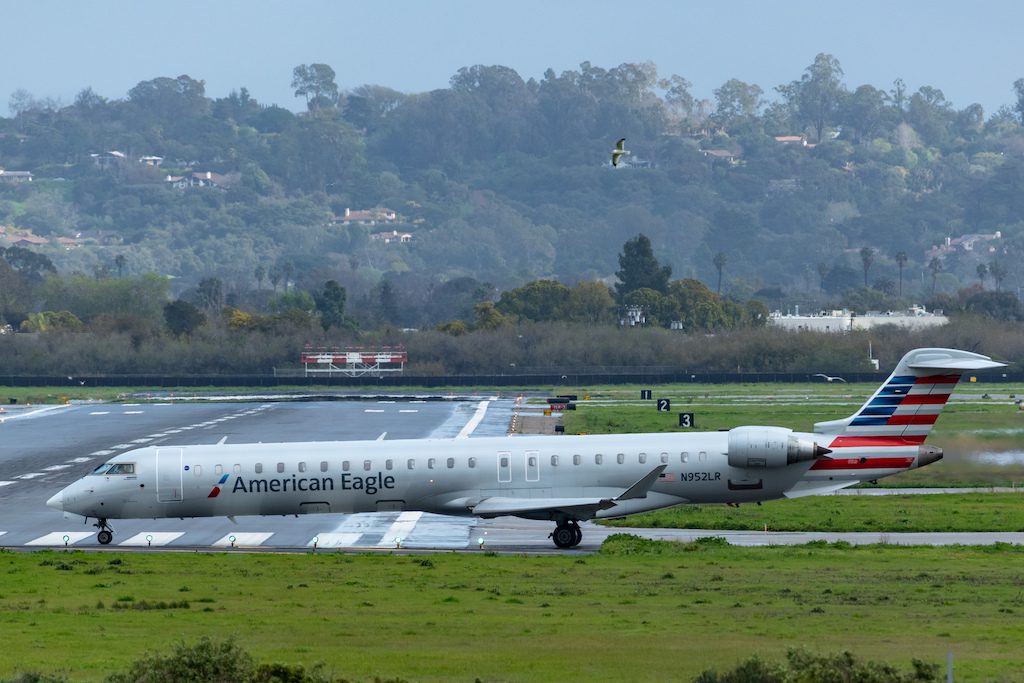Skift Take
U.S. regional airline Mesa Air Group has a relentless focus on costs. But with major carriers trying to increase their customer satisfaction scores, Mesa will need to raise its reliability to win and retain business.
American Airlines wants Mesa Airlines, one of seven regional carriers operating as American Eagle, to improve its reliability, or American could take some of its business elsewhere.
“American made clear they didn’t, quite frankly, want our money,” Mesa CEO Jonathan Ornstein said Tuesday on a conference call with investment analysts. “They wanted the performance.”
American has struggled with its own on-time reliability since merging with US Airways, and recently has placed an emphasis on it, believing it drives customer satisfaction. It is also pushing its contractors to improve, and it sought new contract terms recently with Mesa, which operates more than 60 Bombardier CRJ900s on regional routes, mainly from American’s Phoenix and Dallas/Fort Worth hubs.
Under the new terms, Mesa could win higher incentive payments for reaching operational milestones. But it could also be punished if it does not meet American’s standards.
Mesa has considerable work ahead. Its reliability lags the rest of the industry, according to data from the U.S. Department of Transportation. In October, the most month for which data is available, Mesa finished 16th of 17th U.S. airlines in on-time performance, with 73 percent of flights arriving within 14 minutes of schedule. Mesa also canceled 2.76 percent of all flights, significantly more than another carrier. The figures include flights Mesa operates for United Airlines, its other major customer.
Regional airlines will always be less reliable than major airlines, in part because major carriers ask regionals to cancel departures during bad weather, as they prioritize jets with more seats. But as Delta Air Lines, American and United have focused on reliability in the past five years, they have asked their regional partners to raise their operational performance. The Big Three increasingly want passengers to see regional partners as an extension of their brands, both for reliability and onboard product.
This is a big change, Orestein said. A decade ago, he said, American might have paid Mesa incentives if it canceled fewer than 1 percent of departures. Now, he said, that’s “barely acceptable.”
“The performance levels at both American and United have just been raised significantly and we just need to perform at that level if we’re going to be competitive,” Ornstein said.
American Approached Mesa
Mesa long has been among the lowest-cost U.S. regional airlines, and that made it popular when major carriers were losing money and prioritized cost over everything else.
But today, Ornstein said Mesa can’t win contracts just by being cheaper. “No one is going to buy you because you’re the lowest cost if you can’t operate at the levels they expect in today’s environment,” he said.
Mesa, though, had little incentive to raise reliability. Until recently, Ornstein said, Mesa was operating under a barely updated 17-year-old contract with American that offered Mesa few financial reasons to improve.
“We went back to American and said, ‘look, we’re willing to … put our money where our mouth is,” he said. “We know we can operate with the best carriers but we do need some issues addressed. They were willing to do that in return for the ability for us to operate at a higher level.
As part of contract renegotiations, he said, Mesa will set aside two aircraft now flying as American Eagle as spares for American and United. Mesa also will increase the amount of “touch time” for each American Eagle aircraft, or time the jets spend in the hangar. Mesa was the launch customer for the CRJ900 in 2003, flying them for American corporate predecessor America West Airlines, and as they age, they need more maintenance.
American also will schedule more block time for many Mesa flights, a move that should allow Mesa to pad on-time performance. Flights that had been slated as late could now arrive on-time, according to DOT guidelines.
Mesa will receive extra payments from American if its reaches it goals, though Ornstein did not give details on the deal’s incentive structure. If Mesa does not meet American’s standards, the airline can remove up to six aircraft from the contract beginning in September.
In an email, an American spokeswoman said the carrier renegotiated the agreement, “…so that both parties have an even greater focus on operational reliability.” She added, “We are focused on improving our operating performance.”
This story has been updated with more up to date information about the number of regional carriers operating as American Eagle. It is also been updated to correct the spelling of Mesa CEO Jonathan Ornstein’s name.
The Daily Newsletter
Our daily coverage of the global travel industry. Written by editors and analysts from across Skift’s brands.
Have a confidential tip for Skift? Get in touch
Tags: american airlines, mesa air group, united airlines
Photo credit: Mesa Air Group operates Bombardier CRJ900 aircraft for American Airlines Glenn Beltz / Flickr
